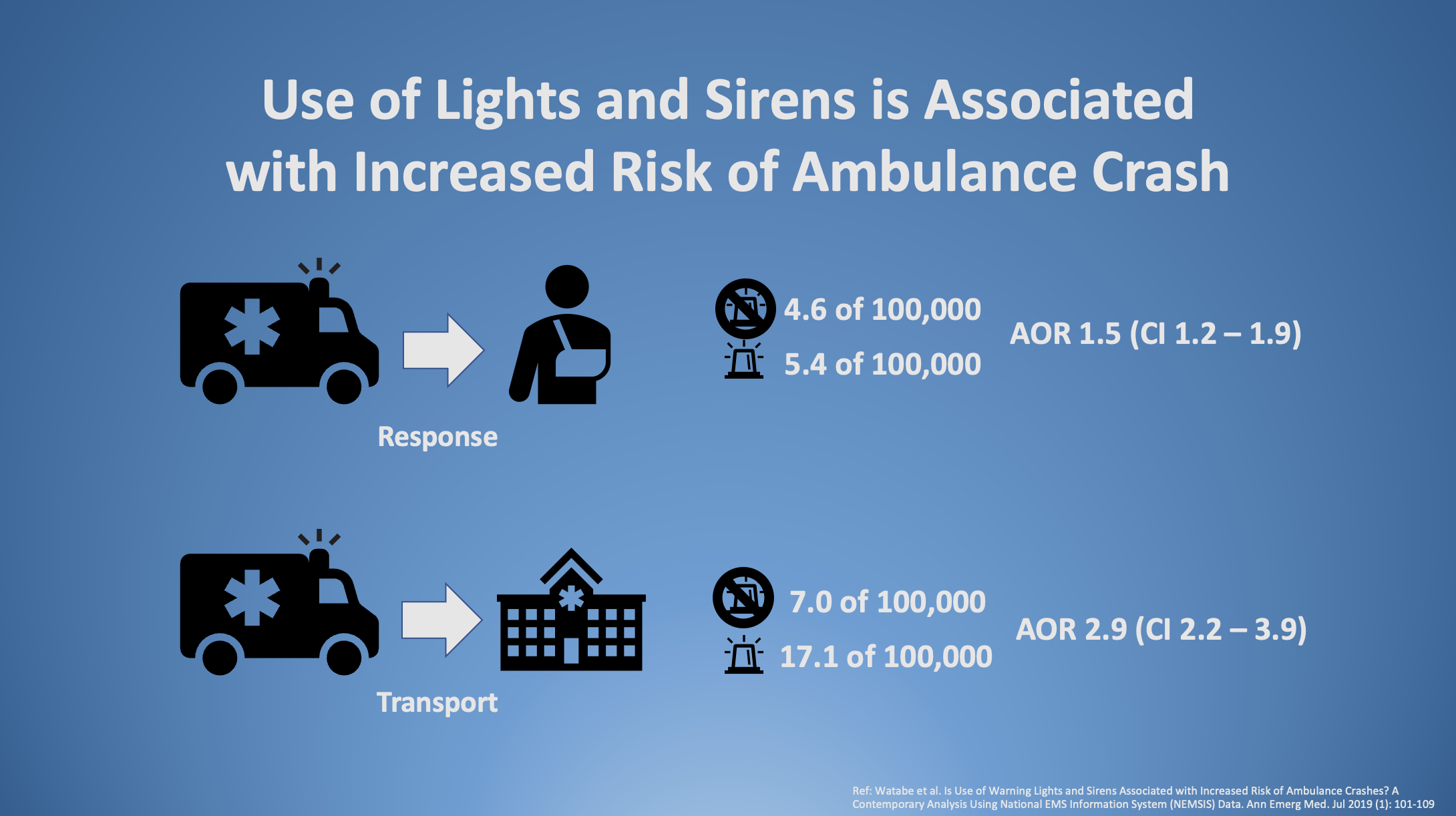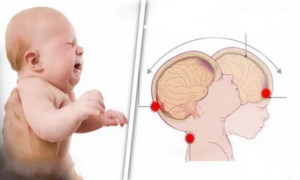Article Summary by James Li, MD (@jamesli_17)
Article:
Background:
Emergency response vehicles frequently utilize lights and sirens to respond to the scene of a 911 call and to transport critical patients to the hospital. The thought process of lights and sirens utilization is that it results in more rapid treatment of patients with a time-critical diagnosis. However, a review of the literature by Murray et al. in 2017 found the use of lights and sirens for response and transport only saves between 43.5 to 181 seconds in urban and up to 363 seconds in a rural settings. [1] A study based in New Jersey found average time savings of 2.62 minutes during the transport phase of care, however none of the patients received time-critical hospital interventions within time saved by utilizing lights and sirens. [2]
There are significant risks to emergent transport with lights and sirens. The risk of transportation-related injury for EMS personnel has been reported to be about five times higher than national average and result in fatalities, injuries, and lost workdays. [3] The number of emergency response accidents may be greater than reported due to the “wake effect”. A “wake effect” collision is due to emergency vehicle transit but does not involve the emergency vehicle. A survey-based study in Salt Lake City suggested that this is a real phenomenon and likely outnumbers accidents involving the emergency vehicle. [4]
Methods:
This was a retrospective cohort study that used NEMSIS data from 2016 to identify EMS scene responses and patient transports. The authors excluded interfacility transports, intercepts, medical transports, standbys, response by non-transport vehicles, mutual aid, supervisor response, and air responses. They used the “type of response delay” and “type of transport delay” fields as a proxy to identify responses and transports that were delayed due to a crash involving the ambulance. Responses and transports documented as “no lights and sirens” served as a control group for their analysis. Multivariable logistic regression with clustered standard errors were used to calculate adjusted odds ratios for rate of crash-related delays per 100,000 responses or transports.
Results:
In this analysis the authors reported lights and sirens use during response was 77% and during transport was 23%. Among the 19 million emergency scene responses included in analysis, the response phase crash rate was 4.6 of 100,000 without lights and sirens and 5.4 of 100,000 with lights and sirens. The adjusted odds ratio was 1.5 (95% CI 1.2 to 1.9).
The transport phase crash rate was 7.0 of 100,000 without lights and sirens and 17.1 of 100,000 with lights and sirens. The adjusted odds ratio was 2.9 (CI 2.2 to 3.9).

How does this affect EMS?
This analysis adds to the existing data that lights and sirens have significant risks to safety, patients, and EMS personnel. The greatest risks occur during the transport phase of care. There is likely significant underreporting of accidents do not directly involve the emergency response vehicle due to the wake effect.
Given existing data that does not suggest a significant time savings to lights and sirens transport, in many situations, the harms may not outweigh the potential benefits. Indeed, EMS may opt for judicious use of lights and sirens during response based on analysis of dispatch codes . After arriving on scene to assess the patient, there can be careful consideration of the risks and benefits of lights and sirens transport. It may be important for QA/QI of dispatch data to monitor for overtriage and undertriage of medical emergencies to ensure appropriate use of lights and sirens to scenes.
Indeed, reducing unnecessary lights and sirens use to the scene and during the transport phase of care are two of the national quality measures released by the National EMS Quality Alliance. Together with key stakeholder organizations, the National Association of EMS Physicians recently released a Joint Statement on Lights and Siren Vehicle Operation on Emergency Medical Services Responses in February 2022. [5]
Bottom Line:
Lights and sirens response/transport is associated with increase ambulance accidents which impact the safety of patients, EMS clinicians, and public. EMS leaders should advocate for using quality, evidence-based emergency medical dispatch protocols to identify calls that require lights and sirens.
References:
1. Murray, B., & Kue, R. (2017). The use of emergency lights and sirens by ambulances and their effect on patient outcomes and public safety: a comprehensive review of the literature. Prehospital and disaster medicine, 32(2), 209-216.
2. Marques-Baptista, A., Ohman-Strickland, P., Baldino, K. T., Prasto, M., & Merlin, M. A. (2010). Utilization of warning lights and siren based on hospital time-critical interventions. Prehospital and disaster medicine, 25(4), 335-339.
3. Maguire, Brian J. “Transportation-related injuries and fatalities among Emergency Medical Technicans and Paramedics.” Prehospital and disaster medicine 26.5 (2011): 346-352.
4. Clawson, J. J., Martin, R. L., Cady, G. A., & Maio, R. F. (1997). The wake-effect—emergency vehicle-related collisions. Prehospital and disaster medicine, 12(4), 41-44.
5. Kupas, D. F., Zavadsky, M., Burton, B., Baird, S., Clawson, J. J., Decker, C., … & Wilson, B. R. (2022). Joint Statement on Lights & Siren Vehicle Operations on Emergency Medical Services (EMS) Responses.
Checkout the PEC podcast Deep Dive episode on lights & sirens use:
https://podcasts.apple.com/us/podcast/pec-podcast-episode-102-deep-dive-series/id925204308?i=1000540159266



